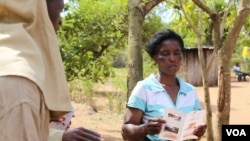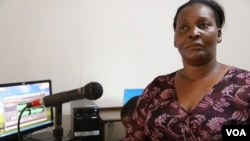With more than half of the population illiterate and its people speaking more than 40 local languages, Mozambique faces colossal challenges in disseminating health information to its population. As the country rolls out new national health campaigns, communication experts are becoming savvier about how they reach Mozambicans.
Fourteen-year-old Fernando emerges from the mobile male circumcision unit in Xinavane, casually pulling his shirt collar up to his ears, giving his approving friends a confident nod. It is a swift procedure, which could help reduce the risk of sexually-transmitted diseases and HIV in Mozambique.
But male circumcision is a hard sell.
Posters dot the mobile unit where nurses carry out around 50 male circumcisions a day. They carry messages such as “I was fearful but I made the right decision," and “Get circumcised and use a condom.”
Boys waiting in line say they learned about the benefits of circumcision from teachers, or their mothers took them after hearing about it from their friends and traditional community leaders.
And community leaders are key in getting out health messages says Patrick Devos, a communications expert who works with non-profit groups and the Mozambican Health Ministry.
“We believe that for real behavioral change, communication has to happen in a community dialogue. We found in formative research that ‘I feel clean,’ ‘I feel healthy, more attractive’ - these kind of things are appealing to younger men… It is about going out, talking to people, having all these focus group discussions. We then try to tailor our messages around things that might appeal to them," said Devos.
Posters and illustrated flip-charts explaining male circumcision, HIV and malaria are devised and pre-tested in coalition with communities to create effective messaging based on language and imagery they understand. In a country where a storytelling tradition is strong, video and audio testimonies have proved to be extremely powerful in facilitating debate and triggering social change, says Devos.
“These days, the reach of television has really grown dramatically but still radio is extremely powerful especially if you can translate your spots into local languages," he said.
Community radio is pivotal in conveying health messages in a country where the Internet is accessed by only 5 percent of the population and more than half the population is illiterate. About 50 percent of Mozambicans have access to a television set but more than 90 percent have access to radio.
Print journalism lacks the dynamism to tackle health issues in-depth, say health groups. Circulation is limited to the southern urban cities and journalists are rarely assigned to cover health care.
A community radio station in Xai Xai, over 200 kilometers from the capital, reaches roughly 3,500 people in a 70-kilometer radius. Here they recruit volunteers as radio presenters due to limited resources. Program coordinator Teresa Zita says radio dramas with health messages and lengthy debates where people can send a text message or speak to a health expert are part of their regular programming.
“We organize different types of debates. For example, next week we will be talking about the Ebola virus and we invite medical practitioners to come and talk about the issue. People call and ask how do you know for example that you have cervical cancer and other types of question. The medical practitioners, sometimes they even leave booklets with information so we can keep on informing the listeners," said Zita.
Across town in Xai-Xai, women look amusedly at the teams of people suited up in beige overalls with a matching hood tasked with going door-to-door as part of an initiative led by the Center for Disease Control and the government. The initiative involves spraying insecticide on the interior walls of homes to kill and deter mosquitoes, and cut down on malaria.
The strange suits give credence to the information teams, who have been chosen from the communities to disseminate information about residual spraying, while familiarizing people with what the technicians will look like when they come to spray homes.
Although it is arduous and time-consuming, many health projects are finding that the door-to-door approach ensures that those beyond the reach of traditional media receive vital, life-saving information.
Gillian Parker traveled to Mozambique with the International Reporting Project.






